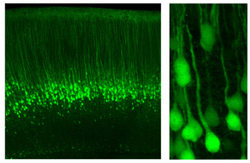
With more than $2.5 million in new grants, P. Hande Ozdinler, PhD, assistant professor of neurology, is continuing to investigate the development of amyotrophic lateral sclerosis (ALS).
The awards, two from the National Institutes of Health (NIH) and one from the ALS Association (ALSA), will fund projects investigating the molecular mechanisms behind the disease, further studying a gene crucial to the lab’s most recent discovery, and creating new mouse models.
“As we learn more about the genetics of ALS, we have come to realize that there are multiple genes involved,” said Ozdinler, a member of the Robert H. Lurie Comprehensive Cancer Center of Northwestern University. “With that as our starting point, one of our goals is to identify the pathways these genes affect.”
The new awards arrive on the heels of Ozdinler’s work published in The Journal of Neuroscience this spring. In that preclinical study, her lab isolated the motor neurons in the brain that die in ALS, giving them fluorescent tags so they can be easily seen. The process removes the complexity of pinpointing and extracting these neurons during surgery, a practice previously beyond the scope of most scientists.
“I think the discovery is really going to open up the field because, for the first time, we are able to easily study these cells, make mouse models, and do drug discovery,” Ozdinler said. “Scientists used to ignore the upper motor neuron as too complex, but our lab’s focus for the past five years has truly paid off.”
Supported by the Les Turner ALS Foundation and the Wenske Foundation since arriving at Northwestern University Feinberg School of Medicine in 2008, Ozdinler’s recent successes have been a half-decade in the making.
“Without that initial support, none of this would have been possible,” she said. “When you build a skyscraper, you first set the footings and establish the foundation. I think the pillars are strong, and we now have the tools and the technology to push ahead.”
NIH Grants
Previous to Ozdinler’s discovery, scientists were able to flag spinal cord motor neurons in fluorescence, but it wore off as the neuron aged. Ozdinler wanted a longer lasting effect so scientists could study the neuron as it ages and develops ALS. She sorted through thousands of genes before she found one – UCHL1 – that is expressed through adulthood.
She used that gene as a promoter to express a fluorescent molecule and created a mouse model whose upper motor neurons are tagged green. She then mated it with an ALS mouse model. The result is an animal model with fluorescent diseased motor neurons in the brain. Ozdinler’s developmental (R21) grant was awarded to generate differing types of these mice.
The new NIH-R01 grant will investigate why the UCHL1 gene helped to label those upper motor neurons affected by ALS.
ALSA Support
One of two Les Turner ALS Foundation labs at the medical school, Ozdinler’s is unique in that it focuses on the upper motor neurons. There are about a hundred thousand upper motor neurons affected in ALS out of some 2 billion cells in the brain.
But the brain’s motor neurons are a key piece of the ALS puzzle. Their disintegration explains why the disease advances more swiftly than other neurodegenerative diseases. It had previously been thought that the spinal motor neurons died first and their demise led to the secondary death of the brain’s motor neurons. But Ozdinler’s work showed that the motor neurons in the brain and spinal cord die simultaneously.
Her new ALSA grant will be used to investigate the molecular mechanisms behind corticospinal motor neuron degeneration. The lab will be isolating these neurons during an early stage in their development using fluorescent-activated cell sorting and will be conducting a host of testing to see which genes are being affected.
“The more we characterize these neurons, the more scientists are going to benefit from them and the research is going to increase in volume and impact,” Ozdinler said.
ALS, also known as Lou Gehrig’s disease, causes the death of muscle-controlling nerve cells in the brain and spinal cord (motor neurons). It results in rapidly progressing paralysis and death usually within three to five years of the onset of symptoms.
“We’re thrilled to be partnering with Feinberg and Dr. Ozdinler as she advances her research,” said Wendy Abrams, executive director of the Les Turner ALS Foundation. “Providing critical support over the past five years, we look forward to many more new discoveries and are excited to see the investment that others are now making in her work.”






